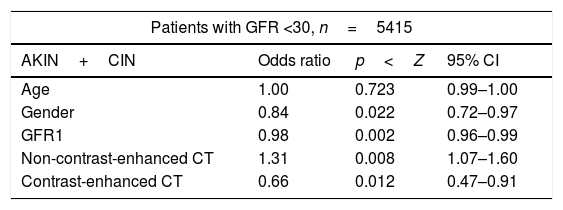To determine whether the intravenous administration of iodinated contrast material for computed tomography (CT) is associated with an increase in creatinine levels and acute kidney injury.
Material and methodsThis retrospective cohort study included all patients who presented at the emergency department between 2010 and 2015 with baseline creatinine measurement (C1) and follow-up creatinine measurement (C2) between 24 and 72h later. The clinical research ethics committee approved the study. The exclusion criteria were age <18 years, creatinine ≤0.4mg/dl or ≥4.0mg/dl, and the administration of contrast media within the previous 6 months. The mean number of patients presenting at the emergency department was 105,435.6 per year. Patients who met the inclusion criteria were classified into three groups: those who underwent contrast-enhanced CT (n=6642), those who underwent noncontrast CT (n=6193), and those who did not undergo CT (n=33,802). We used the Acute Kidney Injury Network's (AKIN) and the Contrast-induced Nephropathy Consensus Working Panel's (CIN) criteria. Statistical analyses included bivariate statistics and logistic regression. Stata 15 was used for all statistical analyses.
ResultsWe analysed 52,411 patients; after data cleansing: 46,637; mean age: 67.95 years; C1: mean 1.16mg/dl (SD: 0.61); C2: 1.14mg/dl (SD: 0.66). With AKIN and CIN criteria: contrast-enhanced CT was not associated with a greater probability of developing nephropathy (odds ratio [OR: 0.90; 95% CI: 0.83–0.99] and [OR 0.89, 95% CI: 0.81–0.98], respectively). The propensity score matching study using both sets of criteria (AKIN+CIN) yielded OR 0.80 [95% CI: 0.77–0.84]. Glomerular filtration rates less than 30ml/min were not associated with increased kidney damage [OR: 0.66, 95% CI: 0.47–0.91].
ConclusionThe administration of intravenous contrast material in the patients studied is not associated with increased acute kidney injury.
Conocer si la administración intravenosa de contraste yodado en la tomografía computarizada (TC) se asocia a un aumento en los niveles de creatinina y de daño renal agudo.
Material y métodosEstudio de cohortes retrospectivo. Incluye todos los pacientes que acudieron al servicio de urgencias del 2010 al 2015 y que presentaban una creatinina basal (C1) y otra 24-72 horas después (C2). El Comité de Ética y de Investigación aprobó el estudio. Criterios de exclusión: paciente menor de 18 años, creatinina ≤0,4mg/dl, ≥4,0mg/dl y administración de contraste en los últimos 6 meses. Al servicio de urgencias acudieron una media de 105.435,6 pacientes/año. Tres grupos de pacientes: 1) TC con contraste (6.642), 2) TC sin contraste (6.193,3) y 3) Sin TC (33.802). Se usaron los criterios de Acute Kidney Injury Network (AKI) y nefropatía aguda por contraste (NAC). Se realizó estudio estadístico bivariante y de regresión logística con el programa (Stata15).
ResultadosSe analizaron 52.411 pacientes; depurando datos: 46.637. Edad media: 67,95 años. Valor de C1: media 1,16mg/dl (DE: 0,61) y de C2: 1,14mg/dl (DE: 0,66). Con criterios AKI y NAC: la realización de TC con contraste no se asocia a una mayor probabilidad de desarrollar nefropatía (odds ratio [OR]: 0,90, intervalo de confianza [IC]: 0,83-0,99 y OR 0,89, IC: 0,81-0,98, respectivamente). El estudio “propensity score matching”, usando ambos criterios (AKI+NAC), obtuvo una OR de 0,80 y una IC de 0,77-0,84. Pacientes con filtrado glomerular inferior a 30ml/min no asociaron incremento del daño renal (OR: 0,66, IC: 0,47-0,91).
ConclusiónLa administración de contraste intravenoso, en el grupo de pacientes estudiados, no está asociada a un aumento del daño renal agudo.
Artículo
Comprando el artículo el PDF del mismo podrá ser descargado
Precio 19,34 €
Comprar ahora














